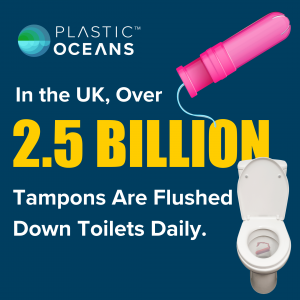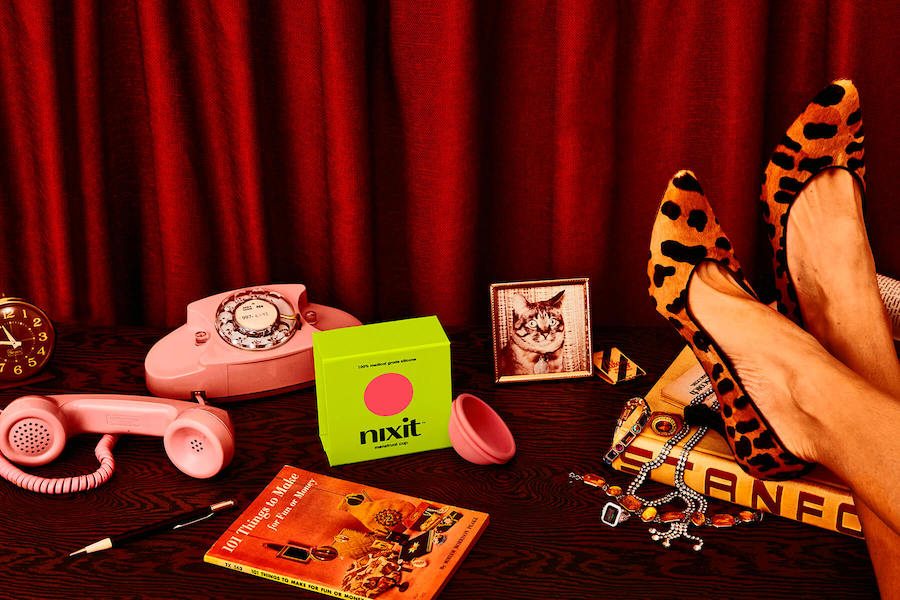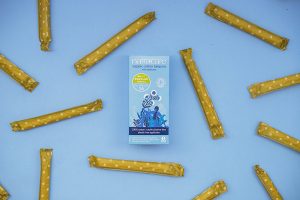Plastic and Periods: It’s Time For A Change
Let’s be honest: periods can be a real monthly hassle … including the menstruation products associated to them.
What’s more, for many of us, the regular complexities associated with menstruation are multiplied by personal guilt that the entire industry is seemingly inextricably linked with plastics: wrappings, applicators, strings, and pads lined with, dare I say, more plastic.

Most menstrual products contain plastic. Photo: Nixit
In total, it’s estimated that over 45 billion period products are used every year … and most contain plastic. In fact, according to a study conducted by Natracare, a pack of typical pads contains about the same amount of plastic as five typical plastic shopping bags!
SCROLL DOWN TO VIEW FULL INFOGRAPHIC PLASTIC & PERIODS: IT’S TIME FOR A CHANGE
Way back when, before ‘convenience’ items became a buzzword for modernity, people used commonplace items during their periods, such as unwanted fabrics, sheep’s wool, and even bark. While many of these items were clearly uncomfortable and inconvenient, they also created a social dilemma: they needed to be cleaned and hung-dry. In a culture that stigmatized menstruation, you can imagine how scandalous it was to publicly display used period products.
Consequently, companies began creating disposable products that could be a never-to-be-seen monthly purchase. They embraced messaging that linked menstruation with shame and developed discreet and disposable products that stigmatized a normal bodily function. And yet the London Assembly Environment Committee estimates that the average menstruator creates over 400 pounds of waste from menstrual products during their lifetime. Not so invisible after all.
What is somewhat invisible is information for the consumer about what period products are made from, which can directly impact female health, as Julie Andersen, CEO of Plastic Oceans International points out: “Tampons and pads are considered medical devices, therefore the FDA here in the US does not require ingredient disclosure. If regulatory bodies do not recognize the health impacts of plastics, women will continue to be exposed to greater plastic and toxins with subsequent health consequences.”

As Susie Hewson, founder of Natracare – producer of organic and natural period products – explains: “Change comes from the heart, which is why Natracare products came to be created – with a low environmental impact and a collective benefit for all.”
Back in the ‘80s, Susie learned disturbing facts about the negative impacts caused by the available period protection at the time and decided to challenge the industry. “I got very unconventional by designing for a change in the products, using only materials with a low environmental impact and positive social benefit. It is not enough to merely ‘say and do’; the commitment to exposing ourselves to independent scrutiny through various certifications demonstrates our honest commitment to meaningful change and creating better options that give back more than is taken out.”
Thirty years on from the founding of Natracare, there are now many more products out there.
Here are five ideas to get you started:
1) Period Underwear
Period underwear is highly absorbent, comfortable, and reusable. From boyshorts to thongs to hip huggers, you can find whatever suits your flow and style. While it may seem unappealing to reuse something you just got all messy, it’s actually just as sanitary as that pad you threw away –– that is, as long as you follow those care instructions! Additionally, there’s far less risk of leakage and ruining your favorite pair of underwear.
Some of my favorite brands are Knix, ModiBodi, and Dear Kates, and their focus on sustainability and women’s empowerment is a huge plus.
2) Biodegradable Pads
If disposable products’ convenience is too good to ignore, then biodegradable pads fit the bill without creating more plastic pollution. These pads have no harmful materials and will degrade in composts and landfills.
Natracare and Ohne produce as they say: “Bullsh*t free organic period products.” Now, that is messaging to get behind.

Nixit and others offer a variety of long-lasting menstrual cups. Photo: Nixit
3) Menstrual Cups
Menstrual cups are also quickly becoming a fan favorite for sustainable periods. A single cup can last up to a decade, easily saving you at least hundreds of dollars that you would’ve spent on disposables… Unlike tampons, they do not dry out the vaginal wall, preserving bacteria vital in preventing infections. For what more could we ask!
Mooncup, AngelCup, Cora Cup, Nixit and Pixie Cup are highly regarded for their excellent menstrual cups.
4) Washable Pads
Similar to period underwear, washable pads can be tossed into the machine after each use –– no waste necessary. If cared for properly, they can last years, outliving a regular pad by hundreds of uses.
Aisle produces long-lasting, washable pads.

Biodegradable tampons, such as these from Natracare, are a great alternative. Photo: Natracare
 5) Biodegradable Tampons
5) Biodegradable Tampons
Biodegradable tampons contain only plant-based materials that naturally break down in landfills. By avoiding the toxins and chemicals in plastic-filled tampons, the risk of infections is far lower, so not only are you doing right by the environment but also yourself.
Natracare, Ohne and Albany Mae produce high-quality biodegradable tampons.
So, let’s go and buy some organic, biodegradable or reusable period products and make sustainable menstruation a mainstream must!
PHOTO AT TOP COURTESY OF NIXIT
INFOGRAPHIC
In collaboration with Natracare, we are delighted to present this infographic that visualizes key data related to traditional period products and the plastic associated to them. Please enjoy and share it with others, along with this blog post. Also, be sure to check out our other infographics:
INFOGRAPHIC: Humans Are Eating Over 40 Pounds of Plastic In A Lifetime
INFOGRAPHIC: 9 Tips For Reducing Your Plastic Footprint
Theresa Barth is a German American journalist. Theresa writes on a wide variety of topics, with a strong focus on socio-environmental issues and impacts – one of the most important topics of our times. She enjoys the outdoors and a cup of hot tea with engaging conversation.



Trackback: ประวัติความเป็นมา saba sport
Trackback: fox888